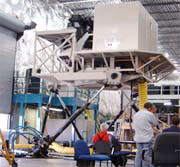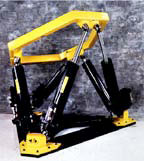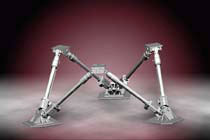It's late and you are tired. It's been a long day. Your job: Army Helicopter Pilot. Your missions: medical evacuation and personnel extraction. After only a few brief moments of sleep, you are rudely awakened by the duty officer and told that you must fly an immediate mission to rescue a downed pilot.
Quickly grabbing your flight gear, you stumble half asleep to the helicopter. Strapping in, your hands, feet and eyes fly over the flight controls, switches and gages, noting engine settings, fuel load, etc. as you quickly bring the bird up to flying status and initiate the mission. Flying low over the jungles, evading enemy locations, you locate the downed pilot through his emergency beacon. You spot the pilot and a clearing sufficient to land in for pick up. As quickly as possible, you load the pilot and clear the area, heading back for base. You continue to fly in an evasive mode to evade enemy detection. The wind picks up and flying is difficult. However, in due time, you arrive back at the base, mission complete.
This same mission continues to be carried out by pilots in various parts of the world. Sloppy flying is often the result of poor training. Poor training can lead to errors and in the worst cases, loss of the helicopter, the crew and the person or persons being rescued/extracted. Bottom line: The better the fidelity of the training, the better the chances of survival. Today, operational flight accidents in US combat are 80% less than they were 30 years ago due to a commitment to training activity and the increase in simulation fidelity. And Moog is on the front lines of this training, providing state-of-the art motion components and motion bases for flight training. Moog has a long history providing hydraulic and all electric motion bases for flight simulation and remains on the forefront of new technology that is re-energizing the industry.
TH-57 Motion Simulator US Navy Trainer
Simulation Requirements
The critical nature of the application is clear when you think of the implications training has for pilots and rescue personnel. When an application means life or death, great consideration is given to the fidelity and reliability of the motion control system.
Simulation training has a broad range of motion requirements. For flight training, there is a need for large actuators with 1.52 m. (60 in.) of stroke and nominal output forces up to 15,000 kg (approximately 32,000 lb.). A training cycle can last up to 4 hours with the flight crew and training instructor inside the instructor hut/cockpit assembly. The cockpit assembly utilizes as much of the "real" bird as possible. Outside of the cockpit is one of several types of visual systems, which projects the appropriate scene to the flight crew.
The motion base has to be capable of moving the hut, cockpit, and visual system. Smooth operation is mandatory, as is low noise generation. The system will sit at mid stroke for the majority of the training period, just as the average passenger experiences during a flight on a commercial airline. However, when the instructor generates a problem, the motion base must respond in any or all six degrees of motion i.e., pitch (tilt up or down) heave (up/down), roll (tilt to the left or right), surge (move forward or backwards), sway (side to side) or yaw (rotation to the left or right). Rapid and violent motion may exist for 1 to 3 minutes and than back to the calm and level flight. However, even with the straight and level flight, motion is still required to generate engine vibration, flap actuation, pump effects, etc.
Driver training has the opposite requirements. Vehicles (off road, marine, or trains) all have high vibration road and track requirements while marine training requires a reproduction of sea states. In these cases, the motion base is almost constantly moving, and though response is critical, smoothness is not as critical in driver training.
Electromechanical/Electrohydraulic Technologies
Moog has been providing components for simulators for over 30 years, first servovalves, than hydraulic actuators (motion legs) and finally complete motion bases. Today, Moog offers motion bases based on either electrohydraulic or electromechanical technologies.
An example of Moog's motion base products is the all digital electrohydraulic six degrees of freedom motion base with a payload capability of 14,500 kg (approximately 32,000 lbs) of flying weight recently delivered to NLX Corporation, an internationally recognized provider of simulation and training systems for military and commercial customers. The application is for the US Navy training center at NAS Whiting for the TH-57 helicopter. (See Appendix A for more details.)
These motion bases represent the integration of Moog's hydraulic background, our capability in system design and integration, and our software development to meet the demands of an industry that requires a 95% or better up time for the complete system (not just the Moog motion base!).
A question an industry insider might ask is “Why use an electrohydraulic motion base when the world seems to be converting from electrohydraulic systems to electro-mechanical systems?” There is no single answer to this question. Every site and application is unique to itself. In large training centers with multiple motion bases, an upgrade of only one base converting to electric would increase the training requirements of the maintenance staff as well as add to the inventory of spare parts. By staying with a hydraulic system, they reduce their overall capital cost and only have a small training delta. For some applications, hydraulics is still the only option. Flight simulators with large flying payload requirements (18,000 kg. (approximately 40,000 lb.) and above) are only addressed with hydraulic components. For 4,500 kg. (approximately 10,000 lb.) to the mid 13,600 kg. (approximately 30,000 lb.) of flying load, either solution will address the requirement from a motion side.
The all-digital motion control cabinet represents an industry trend that is replacing analog signals and processing with digital communication and control loops. Unlike hydraulics where replacement components (and sometimes the original components) are available in the market place, analog components, if available, are becoming harder to find. With all upgrades of the host computer, image generators, etc. utilizing today's personal computers with Ethernet or Firewire communication protocols, the service personnel are already receiving digital training. Thus, the issues of training in digital technology have already been addressed, with the motion base training adding only a small delta.
6DOF5000E 2,500 kg. (5,000 lb.) Payload
For loads less than 4,500 kg. (approximately 10,000 lb.), all electric systems seem to be the general acceptable solution. Here Moog offers the alternate electromechanical technology and provides complete turnkey solutions for 1,000 kg. (approximately 2,000 lb.) payloads (6DOF2000E) and 2,500 kg. (approximately 5,000 lb.) payloads (6DOF5000E). In the intermediate range, Moog's electromechancial systems are similar to the components provided for the hydraulic motion bases. (See appendix B for more information.)
The all-electric flight simulators include electric legs with integral absolute position feedback transducers, and all digital motion control cabinet. Moog also provides the upper and lower joints as well as optional instrument packages used to test the system at commissioning and to run ongoing performance tests such as the operational readiness test. With the data logging features built into the motor controllers and PC, this provides maintenance personnel the ability to test these systems without additional test equipment.
6DOF25000E Motion Base
Current Applications
With Moog's unique position of providing high performance servovalves and associated components and electromechanical servo actuators, we are in a position to offer the technology and performance solution best suited to individual training needs. From replacing and upgrading hydraulic motion bases for current simulators to building state-of-the-art new electric bases, Moog is a leader in providing motion solutions for the industry. All together, Moog has delivered over 350 all electric motion bases and thousands of servovalves and other hydraulic components for this important area of high performance motion simulation in military, commercial, and industrial training.
Summary
Moog is a manufacturer of high performance motion control solutions, providing the “brains” and the “muscle” to address demanding needs. Moog components and systems used in training and certification of pilots, drivers, and crews highlight this capability. Regardless of the muscle technology used, our “brains” of motion simulation uses state-of-the-art digital control topologies with Moog’s motion control software. Our capabilities in electrohydraulic and electromechanical closed-loop systems allows us to address any application, matching the performance and customer desires for specific projects. Moog uses the same approach whether it is a flight training, industrial automation, or a process control application: Apply the right technology based on the need, not just the "production" technology that is "off the shelf."
Appendix A
Moog hydraulic motion base consists of:
- Hydraulic legs – The standard units have 60 inches of stroke. To address system safety, they include integral snubbing at either end of travel and a servovalve with integral abort function. Actuator feedback data is provided by a linear magneto restrictive linear position transducer, pressure transducers and limited switches
- Hydraulic Power Unit (HPU)– This is a state of the art hydraulic power unit with two Moog high performance, variable volume, variable pressure pumps, energy efficient pump motors, filtration, and separate chilling loop. The control circuitry has been designed for both local and remote control capability. This allows maintenance to be performed on the HPU without having the simulator active. The sensor package included with the HPU measures pressure, temperature, and fluid level. Dump and blocking valves are used to quickly remove pressure and isolate the power unit from the motion base during emergency shut down. System blocking valves allow the HPU to achieve full pressure without affecting the motion base during maintenance activity.
- Motion Control Cabinet – This motion controller assembly closes the motion control loops using digital technology. These loops include position, velocity and force loops with appropriate compensation using the feedback transducers mounted on the actuator. The cabinet interfaces with the HPU assembly to monitor and control the HPU functions during simulation. It interfaces with the simulator host computer using Ethernet or Firewire protocols. Motion cueing software, function generators for white noise and discrete frequencies are integrated with the Moog motion software to provide full flight simulation capability.
In addition to these three major components in the simulation system, Moog also supplies the upper and lower joints, filtration and distribution system and all electrical cables between the Motion Control Cabinet, legs, and HPU. Moog provides ongoing support for these systems that includes field installation supervision, training and long term maintenance support of on site personnel.
Appendix B
A Moog motion base consists of:
- Electric legs with integral absolute position feedback transducers. These are 60 inch stroke actuators with greater than 25,000 pound payload capability. They are grease and oil lubricated at the factory and require minimum field maintenance. Patented integral snubbing is provided to protect the simulator from end of stroke peak velocity stops. The snubbing is engaged in the last three inches of stroke in either direction. The snubbing force is proportional to the velocity of the actuator.
- The all Digital Motion Control Cabinet is the equivalent to the pump room and motion control cabinet as described in the hydraulic section. It includes the communication interface, loop closure, and motor controllers. For safety, it includes return to home amplifiers/motor drives, which are battery, backed up emergency circuits similar to the hydraulic abort function. This cabinet is located within the training bay with Moog providing all cables between the legs and the MCC.
About the Author
Charles Bartel, Jr., Simulation Market Manager for the Industrial Controls Division, has been involved with motion control as an electrical design engineer, project engineer, program manager and application engineer throughout his 32-year career at Moog. He has designed and commissioned both electromechanical and electrohydraulic systems. Charles is a Certified Motion Control Instructor and author for the Association of International Motion Engineers.



